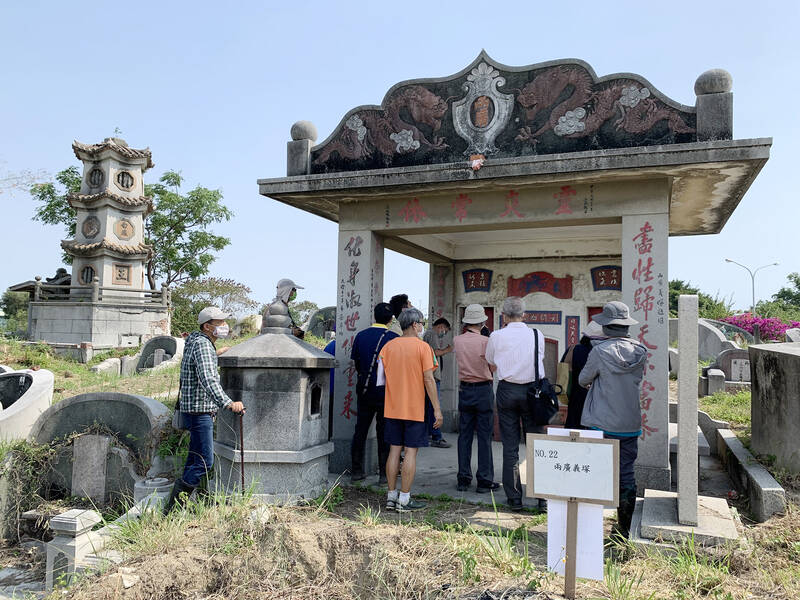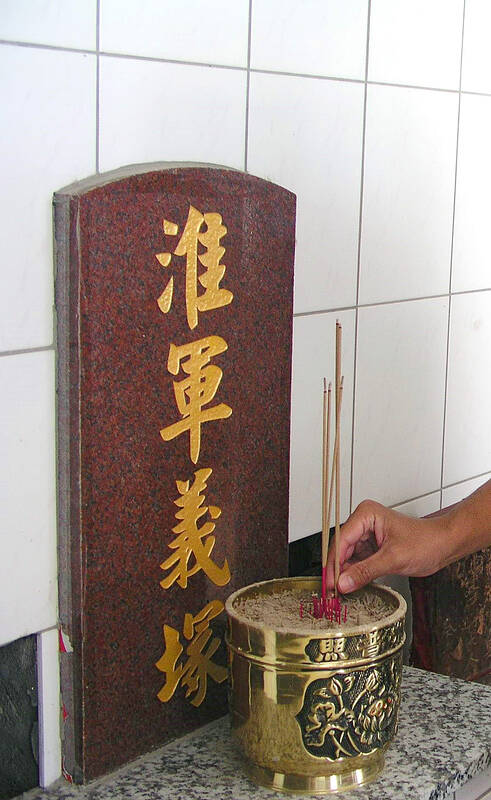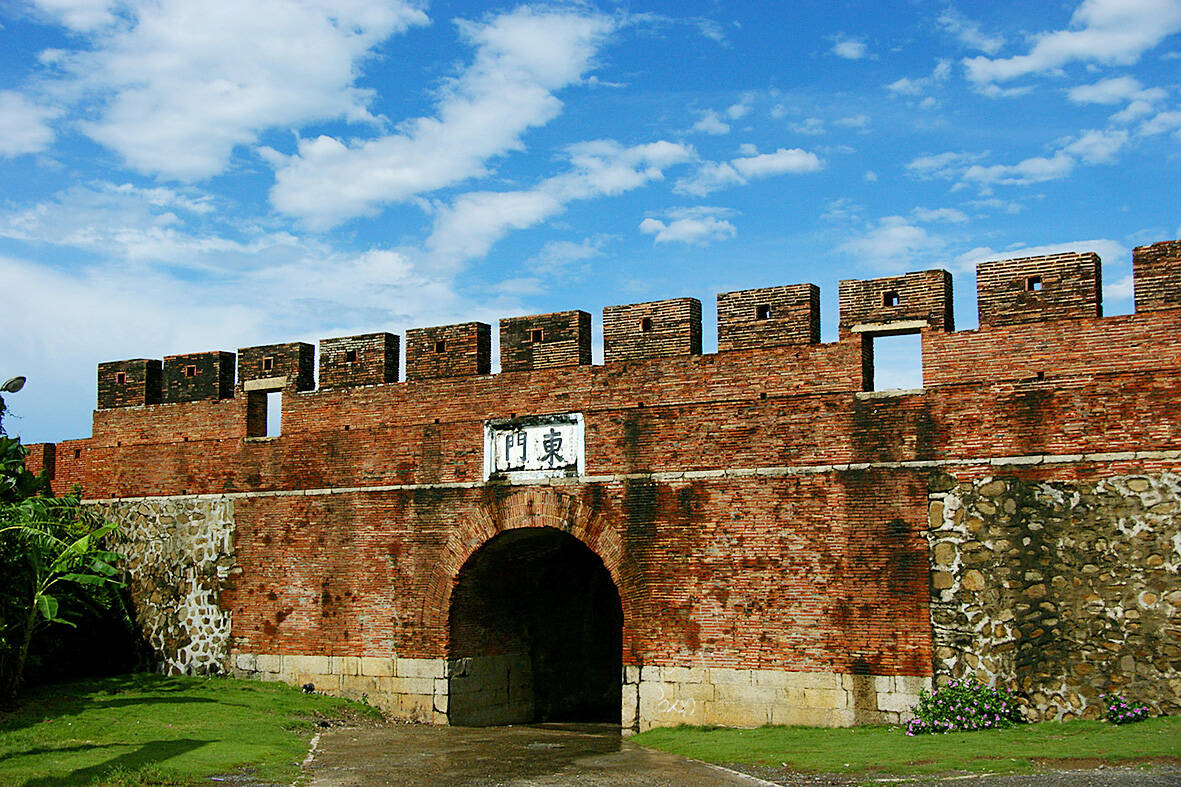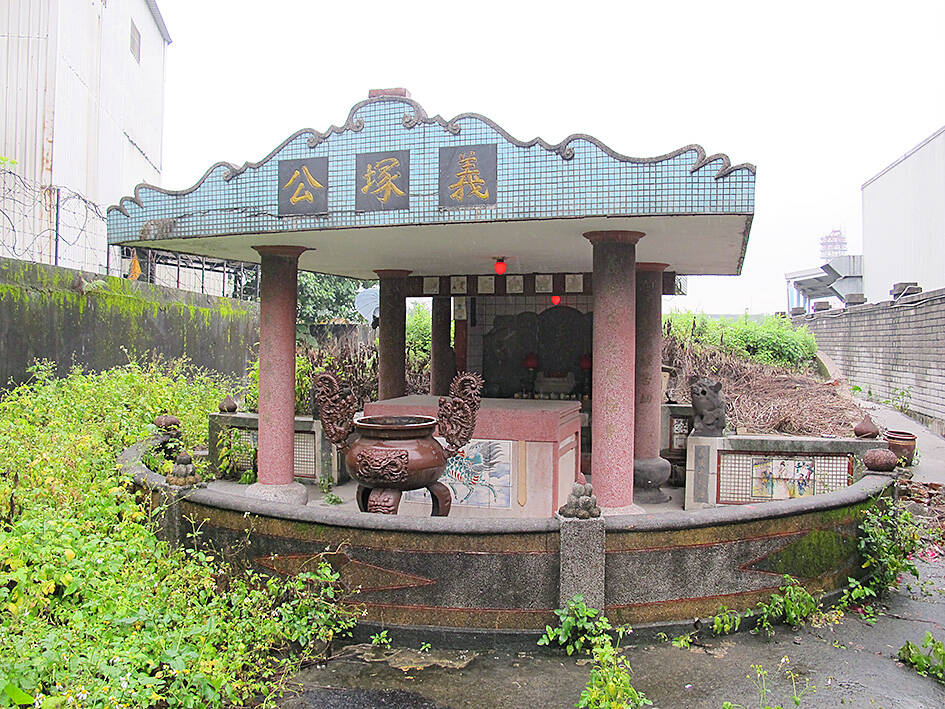May 1 to May 7
Chiang Hsin-tsung’s (江新聰) grandfather would warn him to be careful of the graves outside the east gate of Hengchun (恆春) in Pingtung County. It was on the way to town from their indigenous village, and Chiang was told that the Han inhabitants purposely buried people there so their spirits would scare away their enemies living to the east.
His grandfather was probably referring to the the Lan Army Chu Braves Righteous Grave (蘭軍楚勇義塚), a mass tomb of hundreds of Qing Dynasty soldiers hidden in Hengchun’s First Cemetery. Righteous graves, or charity graves, were constructed by local gentry and government officials across Taiwan during the Qing era to house the remains of mostly unnamed people who had no family or funds for a proper burial.

Photo: Hung Jui-chin, Taipei Times
This righteous grave was paid for in 1879 by military commander Yang Kai-you (楊開友) and 17 local families, including the Chengs (鄭), who renovated it in 1914 and still look after it today.
It is currently under review by the Pingtung County Government for historic site status. With many cemeteries across Taiwan facing relocation, supporters believe the designation is urgently needed to preserve this piece of history, the Liberty Times (Taipei Times’ sister paper) reported on April 19.
Scant information can be found about this tomb, however, aside from a few pages in folklorist Liu Huan-yue’s (劉還月) Historic Road that Runs from East to West: Langqiao and Beinan Trail (貫穿東西的歷史大道: 琅嶠‧卑南道), where Chiang’s account can be found.

Photo courtesy of Wikimedia Commons
The Liberty Times report states that it is a rare example of a well-preserved, Qing-era burial site for soldiers, and that other such sites in Taiwan such as the Hunan Brave ancient tomb in Tamsui (see “Taiwan in Time: The six Braves left behind,” Nov. 29, 2020) are already protected as relics.
CHARITY BURIALS
Since many Han settlers migrated to Taiwan alone during the Qing Dynasty, it was often a question what to do with their corpses if they died unexpectedly, whether it be due to natural disaster, illness, famine, war or other causes. It was costly to ship the bodies back to their ancestral homes in China, which was the preferable option, but there was no family cemetery to bury them in Taiwan, and nobody to care for and worship the tombs. Often they were placed in unmarked graves in the wilderness. There are records of officials paying for the transport of bodies to China, but local burials were more common.

Photo courtesy of Hung Li-wen
The practice of charity burials has existed in China since the Song Dynasty (960-1279), usually carried out by local gentry and government officials. It was considered a virtuous deed to fund such graves, and was one of the various social services the wealthy provided for the less fortunate in Taiwan.
There were two types of righteous graves in Taiwan, according to “Study on charity cemeteries in Qing Taiwan” (清代台灣義塚探討) by Lin Yi-ling (林怡伶): public cemeteries containing many plots, or one large tomb representing tens or hundreds of deceased. They were usually located outside of the cities on unsettled land.
Qing annals show that in the early days of Han settlement in Taiwan, strongmen often seized large swaths of land from peasants and left them without even a place to bury their dead. In response, the government decreed that all uncultivated land, whether public or private, could be used as grave sites, and those who tried to obstruct such burials could be punished. Righteous graves began appearing shortly after.

Photo: Tsai Tsung-hsien, Taipei Times
The earliest recorded righteous cemetery appears in a 1695 annal, located south of Tainan. In 1720, a scholar named Chen Shih-chun (陳士俊) purchased mountainous land in the Fengshan (鳳山) area specifically for poor people to bury their dead.
Lin found a total of 220 recorded righteous graves in Taiwan, more than half of them in Hsinchu and Miaoli counties. These areas were settled later and involved much more violent conflict with indigenous people.
UNNAMED SOLDIERS

Photo: Hsieh Chia-chun, Taipei Times
Lin writes that the problem of unclaimed bodies was exacerbated as the Qing transferred more troops from China to Taiwan during the 1800s. In addition to dying in war, they had trouble adapting to Taiwan’s environment and succumbed to its many diseases.
The number of soldiers grew significantly after the Mudan Incident of 1874, where a series of events culminated in a Japanese punitive expedition against several indigenous villages in the Hengchun peninsula. That same year, the Qing began implementing the “open up the mountains and pacify the savages” (開山撫番) campaign, resulting in increased military casualties.
The Lan Army was originally stationed in Tainan, but it was later tasked with helping the government with its campaigns against the indigenous population. They were moved to Hengchun in 1875 and helped construct the town’s walls, which are still mostly intact. Commander Yang took charge of them in 1877 after several indigenous uprisings took place on the east coast, and stationed them around today’s Taitung City. They returned to Hengchun in December 1878. The bodies in the Lan Army Chu Braves Righteous Grave are likely casualties from these conflicts.
The Hengchun Annals state that the Chu Braves refer to a group of warriors under the Xiang Army (湘軍) brought to Taiwan by general Sun Kai-hua (孫開華). They arrived in Taiwan after 1871 and fought in various battles, including the Dagangkou incident (大港口事件, Karawrawan a demak no Cepo in Amis) against the indigenous Amis in today’s Hualien.
LOCATION MATTERS
Liu writes that at just 1km from Hengchun, the First Cemetery is unusually close to town. It’s also odd that it’s located beyond the east gate — since the sun sets in the west, graves are usually located on that side of the settlement.
He surmises that since there was still much conflict with the indigenous living to the east of Hengchun when the graves were built, the burial grounds had to be located near town. The bodies in the graves weren’t necessarily all soldiers; many Han Taiwanese ventured into indigenous territory to seek profit or hunt treasures, and when they lost their lives, their compatriots had to go collect the bodies. Therefore, it was convenient to place the cemetery on the east side along the major throughway.
In addition, since many of the soldiers died fighting indigenous people, Liu writes it’s possible that the bodies were purposely placed by the east gate to scare their enemies and reassure the Han inhabitants that the spirits of these dead soldiers protected the town.
In addition to the Lan Army Chu Brave tomb, there’s another righteous grave outside the east gate built in 1883 for soldiers from eastern Guangdong. This site is also cared for by the Cheng family since it’s on their land, Liu writes.
Taiwan in Time, a column about Taiwan’s history that is published every Sunday, spotlights important or interesting events around the nation that either have anniversaries this week or are tied to current events.

Most heroes are remembered for the battles they fought. Taiwan’s Black Bat Squadron is remembered for flying into Chinese airspace 838 times between 1953 and 1967, and for the 148 men whose sacrifice bought the intelligence that kept Taiwan secure. Two-thirds of the squadron died carrying out missions most people wouldn’t learn about for another 40 years. The squadron lost 15 aircraft and 148 crew members over those 14 years, making it the deadliest unit in Taiwan’s military history by casualty rate. They flew at night, often at low altitudes, straight into some of the most heavily defended airspace in Asia.

Taiwan’s democracy is at risk. Be very alarmed. This is not a drill. The current constitutional crisis progressed slowly, then suddenly. Political tensions, partisan hostility and emotions are all running high right when cool heads and calm negotiation are most needed. Oxford defines brinkmanship as: “The art or practice of pursuing a dangerous policy to the limits of safety before stopping, especially in politics.” It says the term comes from a quote from a 1956 Cold War interview with then-American Secretary of State John Foster Dulles, when he said: ‘The ability to get to the verge without getting into the war is

Beijing’s ironic, abusive tantrums aimed at Japan since Japanese Prime Minister Sanae Takaichi publicly stated that a Taiwan contingency would be an existential crisis for Japan, have revealed for all the world to see that the People’s Republic of China (PRC) lusts after Okinawa. We all owe Takaichi a debt of thanks for getting the PRC to make that public. The PRC and its netizens, taking their cue from the Chinese Communist Party (CCP), are presenting Okinawa by mirroring the claims about Taiwan. Official PRC propaganda organs began to wax lyrical about Okinawa’s “unsettled status” beginning last month. A Global

Like much in the world today, theater has experienced major disruptions over the six years since COVID-19. The pandemic, the war in Ukraine and social media have created a new normal of geopolitical and information uncertainty, and the performing arts are not immune to these effects. “Ten years ago people wanted to come to the theater to engage with important issues, but now the Internet allows them to engage with those issues powerfully and immediately,” said Faith Tan, programming director of the Esplanade in Singapore, speaking last week in Japan. “One reaction to unpredictability has been a renewed emphasis on